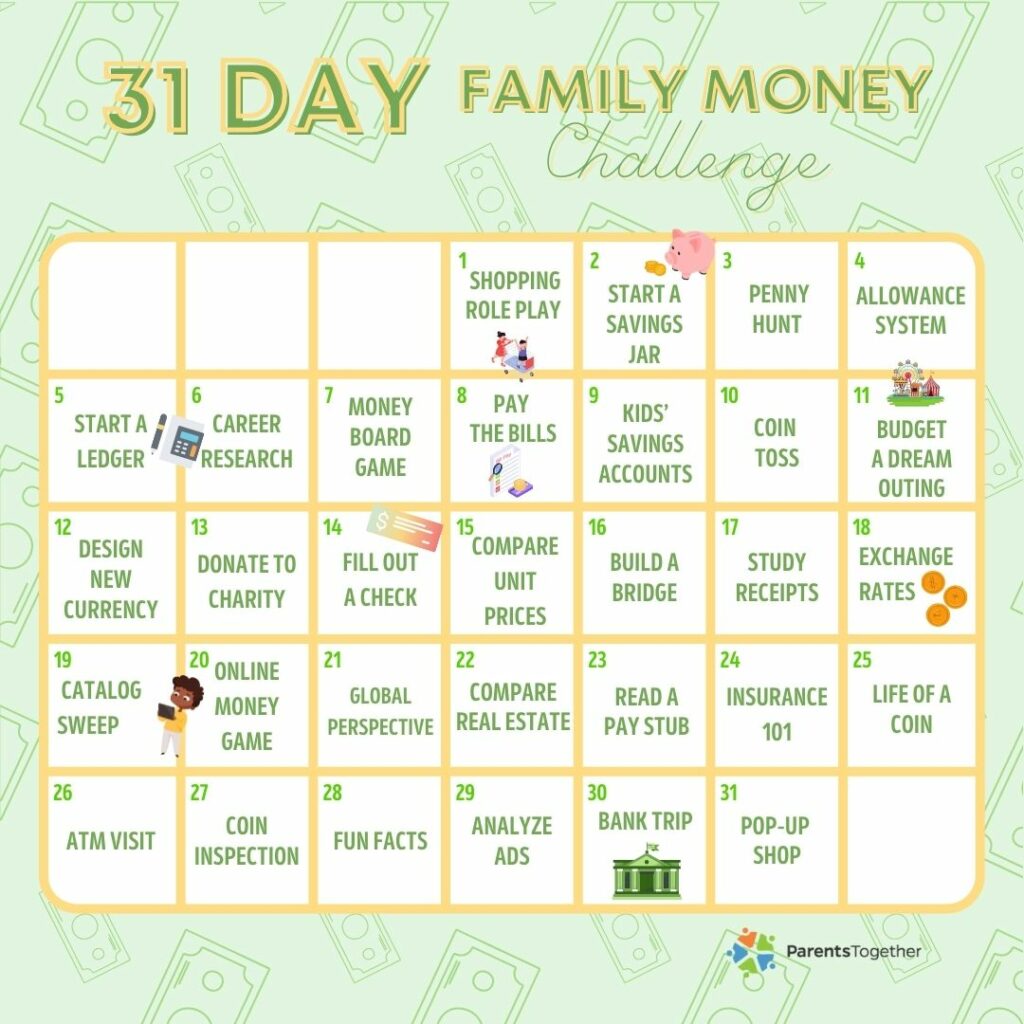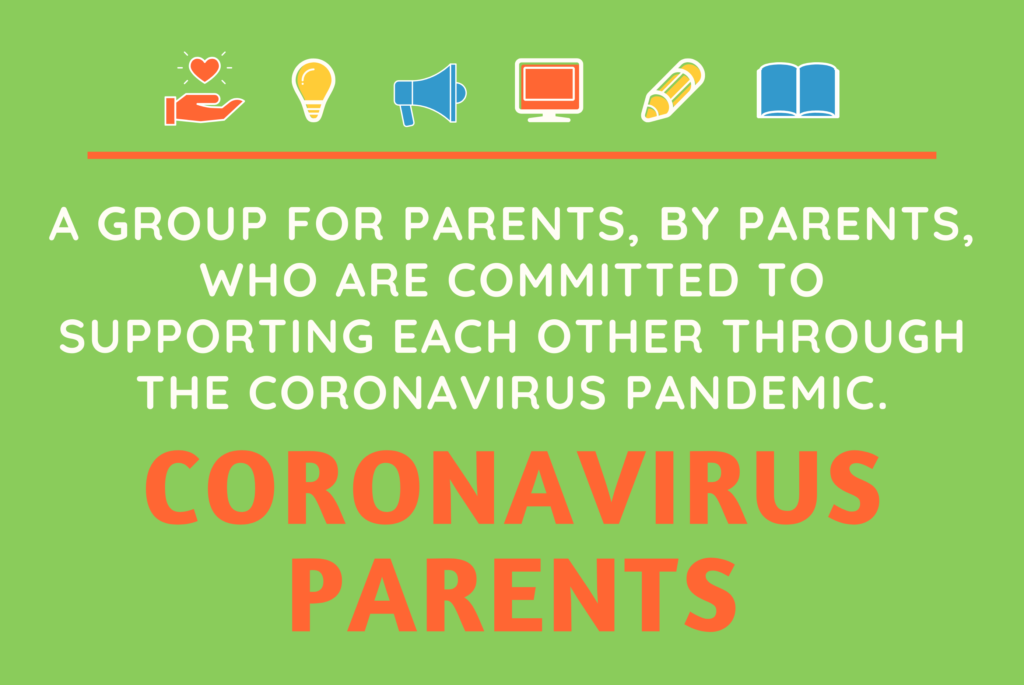How to Save on Your Family Bill Funny Drowing
Click to download FREE PRINTABLES of all our 30-day family challenges!
Money is a tricky topic for many families, but that doesn't mean you should avoid it! In fact, the more you can teach kids about finances, the more likely they will be to manage their money well in the future.
Research shows that money habits and attitudes form by age seven, so starting earlier than that is a great idea! But it's never too late—or too early—to discuss money, whether that's a young child learning what coins are, or an older one learning how to manage a bank account.
Although it may seem like a dry topic or an overwhelming one, there are many kid-friendly (and fun!) ways to introduce and practice money basics. Here's a 31-day challenge to get your kids started on the path to financial literacy. You're likely to learn something new in the process too!

- Shopping role play
Set up a pretend store (for snacks, toys, etc.) with a sign or stickers indicating the price for each item. Give kids real or pretend money to buy things, and take turns acting as the cashier. Older kids can learn to calculate change and figure out discounts, while younger kids can simply learn the amount on each bill/coin. Once they're comfortable, you can let them count and hand over the money the next time you're at a real store!
- Start a savings jar
Put a clear jar out for all family members to drop spare change in whenever they get a chance. Watch it grow over the months, and then vote as a family on what to do with the money when it's full or when you reach a certain date—it could be anything from an ice cream outing to holiday decorations to a donation to an organization you care about.
- Penny hunt
First calculate how much money you have in coins to use for this game. Then hide coins around the house and let kids search for them. At the end, have each child add up the amount of money they have. For younger kids or beginners, just use one or two types of coins to make the counting and adding more straightforward. See if their collections add up to the total amount you hid—if not, the hunt is back on for the missing coins!
- Allowance system
Set up an allowance or money-earning system that works for your family. Maybe this means giving kids a certain amount of pocket money every week or month based on their age. Or maybe it looks more like setting up a list of above-and-beyond chores or helpful tasks that they can complete to earn a little extra money. Either way, offering a consistent, agreed-upon amount for them to spend or save as they wish will give them a chance to hone their financial decision-making skills so they're not dependent on their parents forever!
- Start a ledger
If your kids have an allowance or a piggy bank, it's important to teach them how to keep track of their money. You can do this with a spreadsheet or a simple ledger in a notebook. Make columns for what they earn, spend, save, and donate, and then remind them to calculate their new balance after each transaction.
- Career research
Look up the average salaries and wages of different jobs that your kids are curious about, or in the fields that the adults in your family have worked in. Talk about why salaries differ based on things like education level, specialized skills, location, years of experience, leadership roles, and demand for the job. Discuss the difference between a salaried job and an hourly job, and the potential benefits and drawbacks of each.
- Money board game
Playing with fake money—with rules and low-stakes outcomes—can teach kids a lot of financial basics! Select a money-based game like Pay Day, Monopoly, The Allowance Game, Money Bags, or Act Your Wage for your next family board game session.
- Pay the bills
Have kids join you as you take care of the monthly bills. Show them how the energy bill differs every month, how to locate the due date and amount due on a bill, and the different options for paying. Explain what happens if you don't pay it on time or in full.
- Kids' savings accounts
It's never too early or too late to open a savings account for kids. Or if you already have them, show them their balance over time, the deposits and withdrawals you or they have made, and how interest works. You can even make a list of things you might use the saved money for in the future.
- Coin toss
Try this aiming game for active kids: Take turns tossing a mix of coins into a bowl from a certain distance. Each time a player gets a coin in, they get to keep it. Each time a player misses the bowl, they have to give the coin to the other player. At the end, add up the value of each coin stash to see who won.
- Budget a dream outing
Ask kids what would be the ultimate way to spend their weekend or vacation, and then have them figure out what the budget would be. Whether they choose skydiving on a remote island or a bike ride to the ice cream shop, it's important for them to have an idea of the costs associated with transportation, food and drink, equipment, services, and more.
- Design new currency
Encourage kids to use their imaginations to come up with a currency system for a newly founded country. They can make their own decisions about names, denominations, sizes, materials, and designs to use. Then have them create sample cash and explain to you how to use it!
- Donate to charity
Choose an organization with a cause that you and your family care about—you can even vote on a short list to get everyone involved from the beginning. See how much each family member is willing to contribute, and pool it together. For an added challenge, you can try to double that amount by starting a "matching" fundraiser via social media/text/email to see who else is interested in chipping in.
- Fill out a check
Show kids how to fill out a check and how to void a check. Then then have them design and print their own sample checks to practice! If you don't have access to a printer, you can make some sample checks by hand, or cross out the bank account and routing numbers on some of your old blank checks. Also be sure to explain how and when the money gets transferred to the recipient when you write a real check.
- Compare unit prices
Take kids to the grocery store or browse groceries/toiletries online, and discuss how to accurately compare prices when different brands are packaged in different sized containers. Unit price means the price per pound, ounce, square foot, or individual item. Ask them which items they would buy and why—and why price isn't the only thing to consider!
- Study receipts
Save your receipts for a week or two, and show them to kids. See if they can figure out the total amount you paid, what it was for, how much of it was sales tax, and how much you saved.
- Exchange rates
Make sure kids know that U.S. dollars aren't the only currency in the world! You can make this global learning fun by printing out pictures of different countries' flags and currency symbols to color in (for younger kids), or by having them pretend to buy things with different currencies and calculate the conversion rates (for older kids).
- Catalog sweep
Give kids a catalog from the mail, and have them circle everything they would want from it (making it clear that you're not actually buying the stuff for them). Then have them add up the prices! Bonus activity: Give them a maximum budget and see what they decide to cut from their list.
- Online money game
If your kiddo is really into screen time, there are plenty of online games out there designed to teach money skills to kids in a fun way—try these games for elementary-aged kids and up, and these games for high school students.
- Tell a story
It may be hard to open up about financial woes, but the more specific and personal you get, the more kids will listen. You can tell a story of financial hardship from your past, or a financial dilemma you had recently, without making kids worry too much about your household's financial stability. Ask kids questions like "What would you do in that situation?" or "Who would you ask for help?"
- Global perspective
Zoom out and show kids what terms like poor, low income, middle income, and high income mean when you look at all the countries in the world. This interactive map with statistics can help you and your child understand more about global poverty rates and income inequality. Choose a few countries on various continents and compare their statistics to your country.
- Compare real estate
Take a look at home prices and rental costs in your area. Then compare prices to a different area of the country or state you're in. Talk about what makes the cost of living higher or lower, and answer any questions kids have about how to buy or rent property. Ask them what they would realistically want in a house or apartment (size, location, amenities, etc.) when they grow up.
- Read a pay stub
Next time you get a paycheck, think of it as a learning opportunity for the family. Use the pay stub as a visual guide to explain why you don't take home all of the money you earn. Most adults don't understand all of the jargon on a pay stub either, so use this as a starting guide.
- Insurance 101
Explain what insurance is with a simple video like this. Then tell kids what types of insurance you have for the family—health, home, auto, life, etc. Give an example of something you've used insurance for, and explain how you (or perhaps your employer) pay the premiums.
- Life of a coin
Curious kids will be interested to learn how coins are made at the mint, how long they circulate, and when they retire with these videos and graphics from the U.S. Mint.
- ATM visit
Kids can learn so much from one trip to the ATM with you! If there's no line behind you, you can demonstrate and explain things like checking your balance, making a withdrawal, the various denominations of bills that come out, how to deposit both checks and cash, and the importance of keeping your PIN confidential.
- Coin inspection
Details, details, details… get out a pile of coins and a magnifying glass and get to know what you're looking at! Explore these physical features of coins, and sort them into piles according to which mint they were made at.
- Fun facts
Entertain kids with some of these fun, fascinating money-themed facts, such as the most expensive object ever built, and who has appeared on more currency than anyone else.
- Analyze ads
Part of being financially literate is understanding how corporations try to manipulate your emotions to get you to spend money. That's advertising 101! So pick apart an ad or commercial together, identifying the strategies the company is using to make their product or service appealing.
- Bank trip
Take your child with you to the bank to observe a teller transaction, or bring home an extra deposit and withdrawal slip to show your child how you would fill it out and what happens at the teller counter.
- Pop-up shop
See if your kids are interested in selling something small, whether it's lemonade, hot chocolate, homemade cookies, old toys or books, or hand-knitted scarves. Make a sign or stickers for prices, practice counting out change, and decide what to do with the proceeds. Even if you don't end up selling a lot, it'll be a learning process!
If you enjoyed this, check out our other 30-Day Challenges for families!
- 30 Day Love Challenge
- 30 Day Creativity Challenge
- 30 Day Family Self-Care Challenge
- 30 Day Family "Say Something Nice" Challenge
- 30 Day "Get Outdoors" Family Challenge
- 30 Day Family Brain-Boosting Challenge
- See them all here !
And don't forget to get your free printables for each of these fun and connection-building challenges!

Dealing with school closures, childcare issues, or other challenges related to coronavirus? Find support, advice, activities to keep kids entertained, learning opportunities and more in our Coronavirus Parents: Parenting in a Pandemic Facebook Group.

For ongoing updates on coronavirus-related issues and questions that impact children and families, please find additional resources here.
Want more like this?
Join us on Facebook Messenger for great parenting news and support, sent right to your Messenger inbox. Sign up now to receive quick, concise parenting news on child health, development, behavior, and learning. Plus, stay up to date on all the issues affecting our kids and families.
Get started
Source: https://parents-together.org/31-day-family-money-challenge/
0 Response to "How to Save on Your Family Bill Funny Drowing"
Publicar un comentario